Difference between revisions of "Signal Joining Rings"
(→3M Body Clip) |
(→3M Body Clip) |
||
| Line 34: | Line 34: | ||
=== 3M Body Clip === | === 3M Body Clip === | ||
This ring, more of a C-clip with two carriage holes, is commonly used to bolt together the iconic 3M PV signal. A 3M factory part, and an unusual size and shape limit its usability on standard traffic heads. | This ring, more of a C-clip with two carriage holes, is commonly used to bolt together the iconic 3M PV signal. A 3M factory part, and an unusual size and shape limit its usability on standard traffic heads. | ||
| − | + | ==== Signals used on: ==== | |
| − | + | ===== 3M ===== | |
| − | |||
| − | |||
* M-131 | * M-131 | ||
* M-131R | * M-131R | ||
Revision as of 22:18, 5 November 2014
Contents
- 1 Overview
- 2 Exceptions
- 3 Visual Identification Guide
- 4 Carriage Rings Described by Type
- 4.1 3M Body Clip
- 4.2 Delta Hole
- 4.3 Fan Blade, Clipped Webbings
- 4.4 Fan Blade, Round Webbings
- 4.5 GE Canada Bolt
- 4.6 GE Streamline
- 4.7 Mickey Mouse Shaped, Large Circles
- 4.8 Mickey Mouse Shaped, Oval Bolt Holes
- 4.9 Mickey Mouse Shaped, Small Circles
- 4.10 Oversized, Oval Center Hole
- 4.11 Plastic Shoulder Washer
- 4.12 Round Center, Carriage Only
- 4.13 Round Center, Through-Hole
- 4.14 Serrated Plastic Bolt
Overview
Signal joining rings are known by different names depending on the signal equipment manufacturer. The most common trade name might be carriage ring or tri-bolt washer. [Insert some other names from various manufacturers.] All of these names and hardware are interchangeable. Brought about during the post WWII advent of modular, closed body signal construction, these are the unified flat washers that, along with typically three carriage bolts, join two traffic signal aspects together via the unused pipe mount bosses. This replaced the much less adaptive, sealed, or repairable design of open body signal sections held together with a single set of endplates and tie-rods. When the modular body sections were keyed for serrated locking rings on both top and bottom of the signal aspect it was also possible to create “twisted” signal designs wherein each lens does not need to point in the same direction, they are free to rotate 360° about the mounting axis.
Exceptions
There were a few notable exceptions to the use of carriage rings in closed body signal construction.
Marbelite
Most notably is the earlier body styles of Marbelite signals. Despite having the typical pipe boss and capable of using a tri-bolt ring the castings were molded with three drill out reliefs near the outer extremities of the signal. To assemble, one drilled these three holes on each signal, stacked them, then bolted them together with a bolt and square washer. While an elegant approach, and one could say more reliable, it was eventually eliminated for the common carriage ring design.
Crouse-Hinds
Another, rarer bird, is the rodded CH Type M (Breadpan.) For city specific requirements, this signal was constructed conventionally (with the tri-bolt washer) but available with each body section drilled and rods inserted through them all creating a belt-and-suspenders approach. This was perhaps less of a Luddite approach than it seemed. The Type-M body design did not have any serrations or other keying features on the top of the signal section, only the bottom. When stacking them, it was only the alignment and tightness of the bolts that would retain a signal aspect from rotation.
Visual Identification Guide
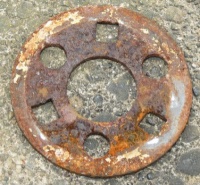
|
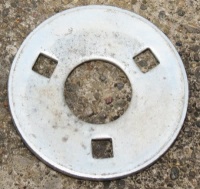
|
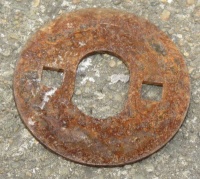
| |
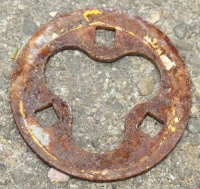
|
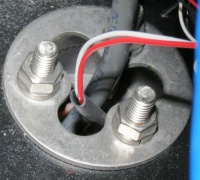
|
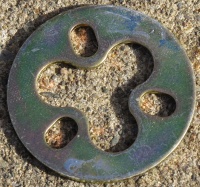
|
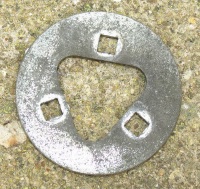
|
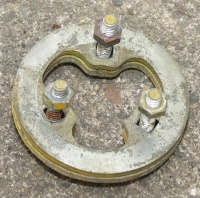
|
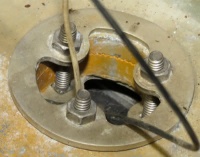
|
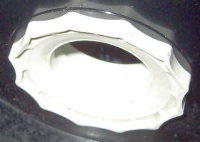
|
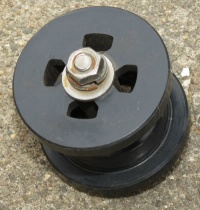
|
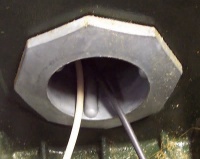
|
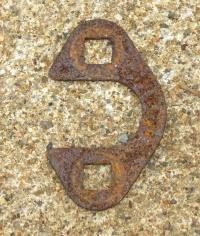
|
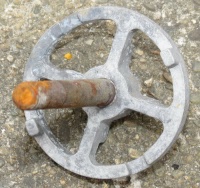
|
Carriage Rings Described by Type
3M Body Clip
This ring, more of a C-clip with two carriage holes, is commonly used to bolt together the iconic 3M PV signal. A 3M factory part, and an unusual size and shape limit its usability on standard traffic heads.
Signals used on:
3M
- M-131
- M-131R
- M-132
- M-133